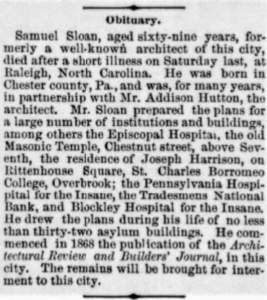Title: Architect
Birthdate: March 7, 1815
Death Date: July 19, 1884
Plot Location: Section 11, Lot 20

Samuel Sloan was one of four children born to William and Mary Kirkwood Sloan in Chester County, Pennsylvania. At a young age, he apprenticed as a carpenter and achieved the position of journeyman carpenter at age 18. Sometime in the 1830s he moved to Philadelphia where he worked building cellblocks at Eastern State Penitentiary. Construction of the original prison was completed in 1836.
For the next decade he worked on various projects throughout the Philadelphia area, but it wasn’t until 1851 that he felt justified in labeling himself an architect. That’s when a wealthy civic leader in Lancaster, Pennsylvania commissioned him to design a multipurpose community center.
 Fulton Hall was erected in 1852 and named for steam engine pioneer Robert Fulton. Once known as the Fulton Opera House, it is one of only a few theaters recognized as a National Historic Landmark (another one being the Walnut Street Theatre in Philadelphia). It has hosted live stage performances, vaudeville, burlesque, and movies over the years, and is still in operation today as a non-profit. Samuel later designed the Lancaster County Courthouse.
Fulton Hall was erected in 1852 and named for steam engine pioneer Robert Fulton. Once known as the Fulton Opera House, it is one of only a few theaters recognized as a National Historic Landmark (another one being the Walnut Street Theatre in Philadelphia). It has hosted live stage performances, vaudeville, burlesque, and movies over the years, and is still in operation today as a non-profit. Samuel later designed the Lancaster County Courthouse.
In 1853 he began a successful business relationship with fellow Philadelphia builder and architect John Stewart. Sloan & Stewart became one of the most influential architectural firms in 19th century America and even after their partnership dissolved in 1857 the two continued working together.
The Panic of 1857 caused bank failures, factory shutdowns, unemployment, and construction stoppages which meant a drop in Samuel’s business. This was followed by the Civil War which impacted architectural design and building when many large projects were brought to a halt.
His buildings made him famous but so did his prolific writing of books and articles on architecture and design. Starting in 1851 he published volumes on the topic and in July of 1868 he began issuing The Architectural Review and American Builders’ Journal, the first architectural periodical published in the United States. Unfortunately, it ceased publication just a few years later when it failed to earn the support of the architectural community. His books, however, continued to sell nationally.
Samuel has been credited for architectural work not only locally but in Ohio, Alabama, Mississippi, Virginia and the Carolinas. After designing the much needed Western State Asylum for the Insane in North Carolina, his popularity in that state grew and other commissions followed.
In 1883, Samuel moved to North Carolina and opened an office in Raleigh. Just a year later, he passed away from heat prostration after extended exposure to the southern summer sun. Six months later he was buried here at Mount Moriah. He had been married for 41 years, had four children and three grandchildren.
His obituary says he designed 32 asylum buildings but he had a special appreciation for homes, as he once wrote in 1871: “The man who has a home feels a love for it, a thankfulness for its possession, and a proportionate determination to uphold and defend it against all invading influences. Such a man is, of necessity . . . a good citizen; for he has a stake in society.”


Support the Friends of Mount Moriah
Help us in our mission to restore and maintain the beautiful Mount Moriah Cemetery by donating to our cause or volunteering at one of our clean-up events.

